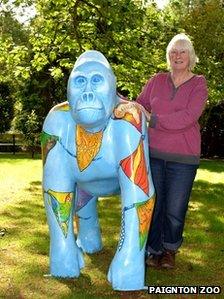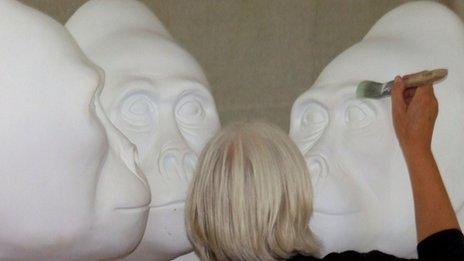Gorilla art trail marks Paignton Zoo's 90th anniversary
- Published

The decorated life-size gorillas will be auctioned off in the autumn
Life-sized gorilla sculptures will be used to create an art "trail" in Torbay and Exeter to mark Paignton Zoo's 90th anniversary.
The public art display next summer will also help to raise awareness of the threats facing gorillas in the wild.
The gorillas will be sponsored by local businesses and community groups and Paignton Zoo is appealing to local artists to paint the sculptures.
Both professional and amateur artists can submit original designs.
Gorilla art map
"It's not often anyone gets the chance to paint a life-size, three dimensional gorilla," zoo spokesman Philip Knowling said.
"I think it's a fitting way to not only raise awareness of the gorilla's plight, but also to thank the community for the support they've given us over the years."
Anna Gilroy from Creative Torbay said: "Anyone can apply - art students, people who simply love to design in their spare time - the competition is open to all.
"Artists can submit as many ideas as they like, but they have to be able to translate those ideas onto the gorilla themselves."
People wanting to be considered have until 4 January to submit their designs.

All the silverback gorilla sculptures will be sponsored by local businesses and community groups
Mr Knowling said if they were inundated with applications, a small panel from the zoo and Creative Torbay would select the artists.
A number of local businesses have already agreed to sponsor a sculpture.
It is hoped to have about 30 to 40 life-size silverback gorillas on the outdoor art trail, although if more sponsors come forward, further sculptures will be produced.
A number of smaller indoor gorilla sculptures are also being produced as an education project for local schools.
The art trail will be launched in the summer, with a map produced showing the location of the gorillas.
The life-size gorillas will be on show for about 10 weeks, after which they will be auctioned off and the money raised will go to the Cross River Gorilla Project and a local community project.
The Cross River gorilla is the most critically endangered ape in Africa, with fewer than 300 left on the Nigeria-Cameroon border.
- Published16 December 2011